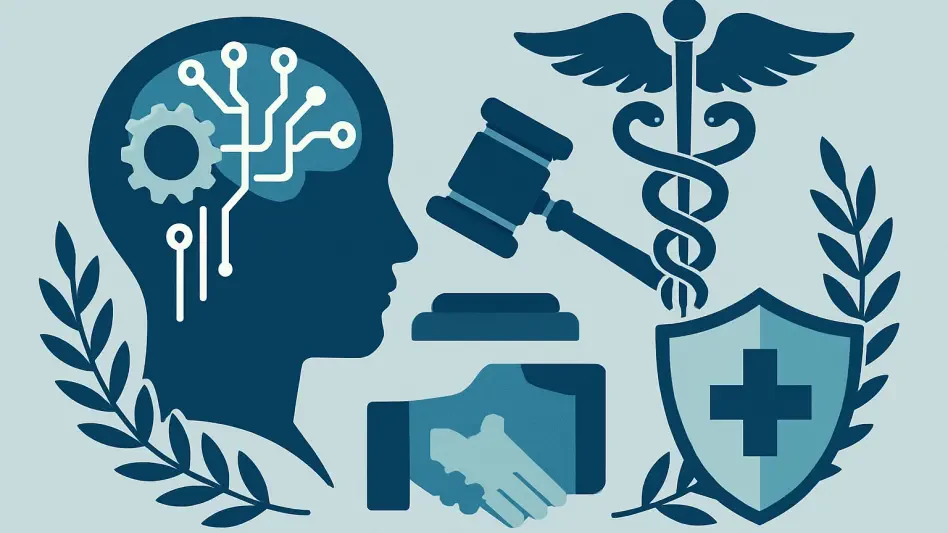The healthcare industry stands at a pivotal moment where artificial intelligence (AI) is no longer just a futuristic concept but a critical tool reshaping patient care and operational efficiency. With administrative burdens weighing heavily on clinicians and the demand for precision in diagnostics soaring, AI has emerged as a transformative force, promising to alleviate these pressures. Yet, as adoption accelerates, a pressing question looms: can governance keep pace with innovation to ensure safety and accountability? This review delves into the capabilities, real-world applications, and governance challenges of AI in healthcare, offering a comprehensive analysis of its current state and future potential.
Core Features and Technological Capabilities
Generative AI for Clinical Support
Generative AI tools have become indispensable in clinical settings by providing point-of-care information and streamlining documentation processes. These systems leverage natural language processing to assist with summarizing patient data, drafting notes, and reducing the time clinicians spend on administrative tasks. Their ability to enhance efficiency is evident in settings where time is critical, allowing healthcare providers to focus more on patient interaction rather than paperwork.
Beyond efficiency, the strength of generative AI lies in its adaptability to diverse medical contexts. These tools can integrate with electronic health records to pull relevant data instantly, offering tailored insights during patient consultations. However, their reliance on accurate input data underscores a key limitation—errors or biases in datasets can compromise outputs, highlighting the need for rigorous validation mechanisms.
Autonomous AI Agents for Decision-Making
Moving beyond supportive roles, autonomous AI agents represent a leap forward in decision-making assistance within healthcare. These systems analyze vast datasets, including patient histories and clinical guidelines, to suggest treatment plans or flag potential issues like medication errors. Their technical prowess lies in machine learning algorithms that continuously improve with exposure to new data, making them powerful allies in complex medical scenarios.
The real-world impact of these agents is seen in their ability to support clinicians under pressure, particularly in high-stakes environments like emergency rooms. Yet, their autonomy introduces significant challenges around accountability—if a recommendation leads to adverse outcomes, determining responsibility becomes murky. This complexity necessitates robust frameworks to ensure that such tools remain aids rather than unchecked decision-makers.
Real-World Performance and Applications
AI’s integration into healthcare spans a wide array of sectors, demonstrating versatility in addressing unique challenges. In women’s health, for instance, AI-driven tools assist in the early detection of conditions like breast cancer through advanced imaging analysis, improving diagnostic accuracy. Similarly, in behavioral health, algorithms help identify patterns in patient data to predict mental health crises, enabling timely interventions.
Another notable application is in value-based care, where AI co-pilots optimize operational workflows by predicting patient admission rates and resource needs. These implementations showcase how AI can drive cost savings while enhancing care delivery. Success stories from various health systems reveal that when paired with clinician expertise, these tools can significantly elevate patient outcomes.
However, performance varies based on the readiness of health systems to adopt such technologies. Disparities in infrastructure and technical know-how among organizations can hinder consistent results, often leading to uneven benefits across the sector. This variability emphasizes that technology alone is not a solution—contextual integration plays a crucial role in effectiveness.
Challenges in Governance and Oversight
Despite AI’s impressive capabilities, governance remains a critical bottleneck in its widespread adoption. The rapid pace of technological advancement has outstripped the development of standardized evaluation frameworks, leaving gaps in ensuring safety and efficacy post-deployment. Technical challenges, such as mitigating biases in AI models, compound the issue, as flawed outputs can have serious implications for patient care.
Ethical and regulatory uncertainties further complicate the landscape, with potential oversight from bodies like the FDA still undefined. Health systems exhibit varying levels of preparedness to govern AI, with some lacking the internal expertise to evaluate or monitor these tools effectively. This disparity poses risks of misuse or over-reliance, especially in under-resourced settings where oversight might be minimal.
Efforts to address these gaps are underway, particularly from vendors and private organizations. Initiatives by groups like the American Heart Association aim to provide guidance on transparency and vetting processes, while some vendors adopt multi-layered approaches to share responsibility with IT teams and clinicians. Though promising, these efforts lack the uniformity needed to establish industry-wide standards, pointing to a pressing need for cohesive action.
Future Trajectory and Potential Developments
Looking ahead, the trajectory of AI in healthcare hinges on bridging the governance gap through collaborative innovation. Potential breakthroughs in standardized frameworks could emerge within the next few years, especially if federal regulations begin to take shape between 2025 and 2027. Such oversight would likely focus on ensuring that AI tools meet stringent safety and performance benchmarks before and after deployment.
The long-term impact of AI on healthcare delivery could be profound, with possibilities ranging from fully integrated decision-support systems to predictive models that preemptively address population health trends. However, achieving this vision requires sustained partnerships among vendors, health systems, and policymakers to align on best practices and accountability measures.
Additionally, the role of education and training cannot be overlooked as a future priority. Equipping clinicians and administrators with the skills to interact with AI tools effectively will be essential to maximize benefits while minimizing risks. As the technology evolves, so too must the human capacity to wield it responsibly, ensuring that innovation serves as a complement to, rather than a replacement for, human judgment.
Final Thoughts and Next Steps
Reflecting on this exploration, AI proves to be a game-changer in healthcare, with its capacity to enhance clinical support and decision-making standing out as transformative. The technology demonstrates remarkable potential in diverse applications, from diagnostics to operational efficiency, though its performance is often tempered by systemic disparities in adoption readiness. Governance emerges as the critical hurdle, with lagging frameworks casting a shadow over otherwise promising advancements.
Moving forward, stakeholders must prioritize the development of unified oversight mechanisms, drawing on the momentum of private initiatives to inform broader standards. Vendors should continue to lead by embedding accountability into their solutions, while health systems invest in building internal expertise. Policymakers, too, hold a vital role in crafting regulations that balance innovation with patient safety. By fostering collaboration across these fronts, the healthcare sector can navigate the challenges ahead and unlock the full promise of AI for better care and outcomes.









